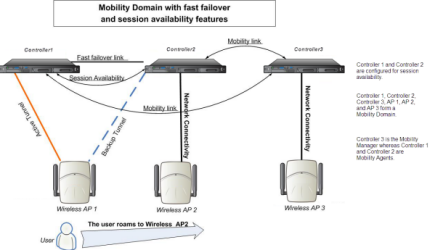Mobility Domain Topologies
You can configure a mobility domain in the following scenarios:
- Mobility domain without
availability
- Mobility domain with availability
- Mobility domain with session
availability

Note
When
configuring a mobility domain with availability or
session availability, synchronize time on all the
wireless controllers that are part of your
mobility domain. For more information, see Configuring Network Time.Mobility Domain with Fast Failover and Session Availability
Features
- The user‘s home session is with Controller1.
- When the user roams from
wireless AP 1 to wireless AP 2, he establishes his home session with
Controller2.
- When the user roams, AP 1
receives a notification that the user has roamed away following which it marks the
user session as “inactive”. Consequently, no statistics are sent to the Controller 1
for that user.
- In response to the heart
beat message from the mobility manager (Controller 3), the Controller 2 sends
updates that the user has a new home on Controller 2. Upon receiving the updates,
the mobility manager updates its own tables.

Note
The mobility
manager‘s heart beat time is configurable. If you are configuring a mobility
domain with session availability, you should configure the heart beat time as
one second to enable the mobility manager to update its tables
quickly.
- If a failover takes place,
and the user is still associated with AP 1:
- AP1
fails over, and establishes an active session with Controller 2.
- In
response to the heart beat message from the mobility manager (Controller 3),
the Controller 2 sends updates to the mobility manager on the failover AP
and its user.
- If a failover takes place,
and the user has roamed to wireless AP 2:
- As part
of roaming, the user‘s home session moves from Controller 1 to Controlle
r2.
- AP1
establishes active session with Controller 2. AP 2 is not impacted by the
failover.




 Print
this page
Print
this page Email this topic
Email this topic Feedback
Feedback